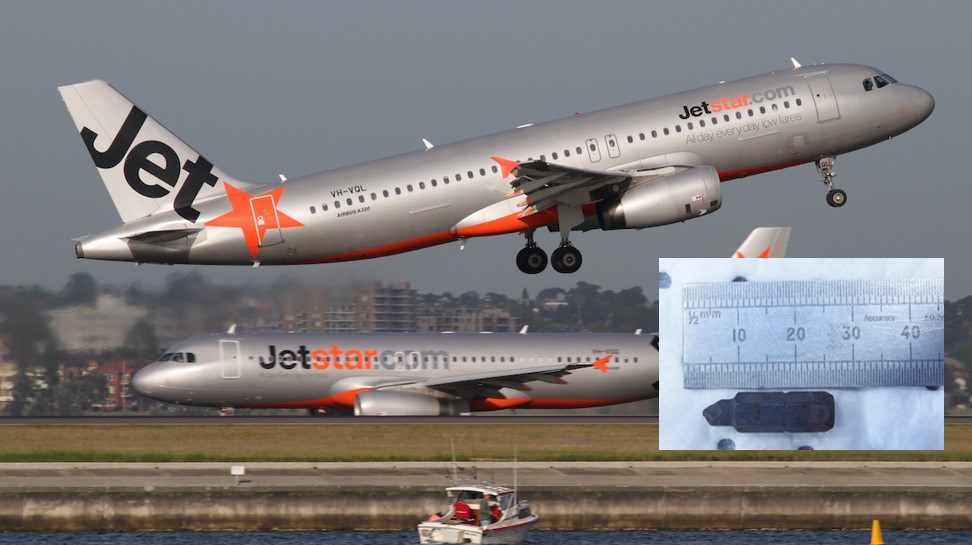
A screwdriver tip left in a Jetstar A320 engine led to a passenger flight being aborted just before take-off, while flames were spotted emerging from the right engine.
An extraordinary ATSB report revealed the flight from Brisbane to Cairns in October 2020 was aborted after the quick-thinking crew “felt a vibration” and heard a “popping noise, which rapidly grew faster and louder”.
It later emerged the screwdriver tip, left there during maintenance, had been residing in the engine for more than 100 flights.
Mike Chapman, Jetstar’s head of safety, called the incident an “extremely rare situation” and said the airline had issued a safety update to its engineering team on tooling checks to ensure it doesn’t happen again.
“The ATSB concluded the tool bit had been left in the engine after maintenance and when the engine was running, it entered the high-pressure compressor, leaving dents and nicks in numerous rotor blades and stator vanes,” said the ATSB’s director of transport safety, Stuart Macleod.
“At least two of these dents and nicks initiated fatigue cracks, which developed during the aircraft’s subsequent operation, and led to a blade failing during the incident flight’s take-off roll.”
The liberated blade then caused greater damage to the engine’s high-pressure compressor, and the engine surged, resulting in the loss of power and the low-speed rejected take-off, said Macleod.
On 23 October 2020, the Jetstar Airways operated A320 was departing on a scheduled passenger flight from Brisbane to Cairns.
As power was being applied for take-off, the crew felt a vibration and heard a popping noise, which rapidly grew faster and louder. At the same time, the aircraft diverged to the right of the runway centreline despite the first officer applying full left rudder pedal.
The captain immediately selected reverse thrust and brought the aircraft to a stop.
Some of the passengers onboard the aircraft, a Brisbane tower air traffic controller, and flight crew of a following aircraft reported momentarily seeing flames coming out of the right engine.
The aircraft was taxied back to the airport gate, and all passengers and crew disembarked safely.
Engineers then reported finding metallic debris in the tailpipe of the aircraft’s right engine. On disassembly, it was discovered the engine’s high-pressure compressor had sustained significant damage. A removable screwdriver tip was found in the engine’s combustion section.
Macleod added that tool control is an important part of maintenance processes.
“Small and seemingly insignificant tool components can, and have, caused significant incidents or accidents,” he said.
Macleod said the incident was also a good example of why flight crews need to be aware that the noise and vibration from an actual engine failure may be greater than, or different to, that experienced during simulator training.
“High-fidelity training devices like full motion flight simulators aim to maximise the realism of an artificial environment, but there is a limit to their ability to replicate extreme events,” he said.
In a statement, Jetstar head of safety Mike Chapman told Australian Aviation, “When commencing take-off, our pilots detected a problem with the right engine. They aborted the take-off at a very low speed and returned to the gate. Following a thorough inspection, engineers found a small tip of a screwdriver in the engine.
“This was an extremely rare situation and we reported the event to the ATSB in accordance with regulations, and assisted them in their investigation. We’ve issued a safety update to our engineering team on tooling checks and procedures to ensure this doesn’t happen again.”
















Ben
says:I think that people should be furious
Its not all about a screwdriver bit that was found
This ‘bit’ caused metal fractures that later fatigued into blade loss causing serious compressor damage and loss of thrust
No one knows if the screwdriver bit came loose and instantly caused damage and engine failure
Or the screwdriver bit caused damage and the plane made flights with blade fractures ready to fail
No one can rule in or out that this failure could have occurred at 30,000 ft some time during the last 100 flights
There is some close call dumb luck in this, and that’s concerns me
Plus – I expect to find that its illegal to use tools on an aircraft engine that are capable of dropping parts
Surely his has been thought through before
So a screwdriver with tiny removable bits is never to be used near an engine
If that’s is not the current procedure then it should be
I would also like to know in what country was that engine serviced over 100 flights ago?
Ben
Concerned Mark
says:I agree with all you raised. Any response yet? This current situation is just not good enough and reaps of Qantas cost cutting to me.
Regards